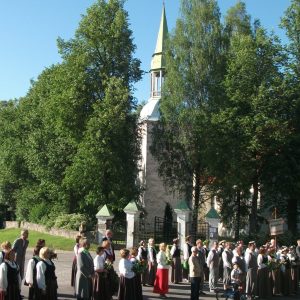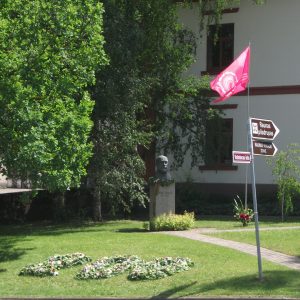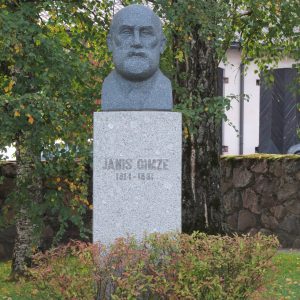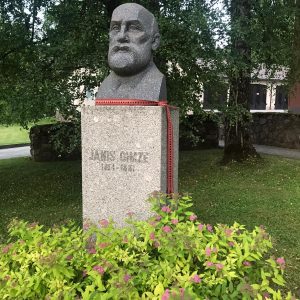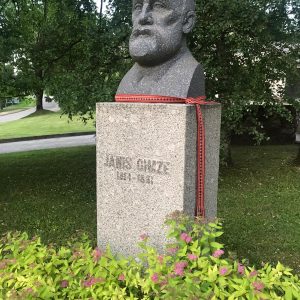Jānis Cimze Monument
Jānis Cimze was born in 1814 at Cimze Semi-manor of Rauna Congregation. Already since the age of 14 he worked as a tutor. From 1836 to 1838, J. Cimze studied at Weissenfels Teachers’ Seminary in Germany, afterwards he travelled through Western Europe and attended lectures at Berlin University. In 1839, J. Cimze was hired as a teacher at Vidzeme Congregation School Teachers’ Seminary in Valmiera, but, starting from 1849, the seminary was moved to Valka to enable the training of teachers for Latvian, as well as Estonian part of Vidzeme. Since 1864, in the official documents, J. Cimze was referred to as the director of the seminary. During his years of work, he raised 431 teachers.
Thanks to the talent of J. Cimze as an educator and a musician, the graduates of the seminary received serious knowledge in music. In 1843, at his initiative, the development of four-part harmony singing started at the seminary, for the first time in Latvia. The spread of multiple-part singing resulted in repertoire problems, therefore J. Cimze started collecting songs suitable for singing. From 1872 to 1881 he published eight parts of “Dziesmu rotas” (Sing Ornaments) collection.
On 20 June 1989, the monument by the sculptor Romualds Getauts was opened in the centre of Rauna. It was dedicated to the greatest countryman, Latvian educator, collector and arranger of folk songs, an organ player, the founder of Latvian choral singing and professional music Jānis Cimze (1814 – 1881). J. Cimze was buried at Lugaži cemetery in Valka.
Gallery
Travel objects
- Rauna Castle
- Rauna Castle Courtyard
- Rauna Park and Rauna Manor Estate
- Rauna Evangelic Lutheran Church
- Rauna Agricultural Society House
- Rauna Freedom Monument
- Rauna Mill
- Strads Pub / Rauna Dairy
- Plūme House / Bookshop
- Rauna Parish House
- Rauna Congregation School / Office of Sarkanais Oktobris Collective Farm
- Rauna Devil’s Cave
- Rauna Staburags (Staburags Cliff of Rauna)
- Jānis Cimze Monument
- Rauna “Pārupe” (Left Bank)
- Baižkalns Manor Estate
- Lauktehnika (Agricultural Equipment Station)
- House of Doctor’s Skaidrais Family / House of psychotherapist Jānis Zālītis
- Rauna Hospital
- Rauna Post Office
- Rauna Pastor’s Manor
- The Centre of Rauna and the visit of USSR leader Nikita Khrushchev
- Rauna Cemetery
- Cemetery of Soviet Soldiers, who Died during the World War II
- Rauna Castle Tower
- Intermediate Passages of Rauna Castle
- Rauna Castle Plastering
- Heating and Smoke Channels of Rauna Castle

